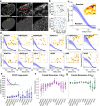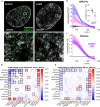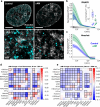Mapping the nuclear landscape with multiplexed super-resolution fluorescence microscopy
- PMID: 40593784
- PMCID: PMC12215941
- DOI: 10.1038/s41467-025-61358-0
Mapping the nuclear landscape with multiplexed super-resolution fluorescence microscopy
Abstract
The nucleus coordinates many different processes. Visualizing how these are spatially organized requires imaging protein complexes, epigenetic marks, and DNA across scales from single molecules to the whole nucleus. To accomplish this, we develop a multiplexed imaging protocol to localize 13 different nuclear targets with nanometer precision. Within single cells, we show that nuclear specification into active and repressive states exists along a spectrum of length scales, emerging below one micron and becoming strengthened at the nanoscale with unique organizational principles in both heterochromatin and euchromatin. HP1α was positively correlated with DNA at the microscale but uncorrelated at the nanoscale. RNA Polymerase II, p300, and CDK9 were positively correlated at the microscale but became partitioned below 300 nm. Perturbing histone acetylation or transcription disrupted nanoscale organization but had less effect at the microscale. We envision that our imaging and analysis pipeline will be useful to reveal the organizational principles not only of the cell nucleus but also other cellular compartments.
© 2025. The Author(s).
Conflict of interest statement
Competing interests: The authors declare no competing interests.
Figures








Update of
-
Mapping the nuclear landscape with multiplexed super-resolution fluorescence microscopy.bioRxiv [Preprint]. 2024 Jul 29:2024.07.27.605159. doi: 10.1101/2024.07.27.605159. bioRxiv. 2024. Update in: Nat Commun. 2025 Jul 1;16(1):6042. doi: 10.1038/s41467-025-61358-0. PMID: 39211261 Free PMC article. Updated. Preprint.
Similar articles
-
Mapping the nuclear landscape with multiplexed super-resolution fluorescence microscopy.bioRxiv [Preprint]. 2024 Jul 29:2024.07.27.605159. doi: 10.1101/2024.07.27.605159. bioRxiv. 2024. Update in: Nat Commun. 2025 Jul 1;16(1):6042. doi: 10.1038/s41467-025-61358-0. PMID: 39211261 Free PMC article. Updated. Preprint.
-
Maternal and neonatal outcomes of elective induction of labor.Evid Rep Technol Assess (Full Rep). 2009 Mar;(176):1-257. Evid Rep Technol Assess (Full Rep). 2009. PMID: 19408970 Free PMC article.
-
Antidepressants for pain management in adults with chronic pain: a network meta-analysis.Health Technol Assess. 2024 Oct;28(62):1-155. doi: 10.3310/MKRT2948. Health Technol Assess. 2024. PMID: 39367772 Free PMC article.
-
Signs and symptoms to determine if a patient presenting in primary care or hospital outpatient settings has COVID-19.Cochrane Database Syst Rev. 2022 May 20;5(5):CD013665. doi: 10.1002/14651858.CD013665.pub3. Cochrane Database Syst Rev. 2022. PMID: 35593186 Free PMC article.
-
Systemic pharmacological treatments for chronic plaque psoriasis: a network meta-analysis.Cochrane Database Syst Rev. 2017 Dec 22;12(12):CD011535. doi: 10.1002/14651858.CD011535.pub2. Cochrane Database Syst Rev. 2017. Update in: Cochrane Database Syst Rev. 2020 Jan 9;1:CD011535. doi: 10.1002/14651858.CD011535.pub3. PMID: 29271481 Free PMC article. Updated.
References
-
- Thul, P. J. et al. A subcellular map of the human proteome. Science356, eaal3321 (2017). - PubMed
MeSH terms
Substances
Grants and funding
LinkOut - more resources
Full Text Sources
Miscellaneous

